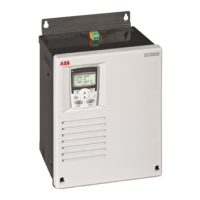138
Winder
3ADW000379R0501 DCS550 Manual e e
FrictionComp (friction / loss compensation)
During the winding operation, the motor must only generate the torque for the
needed tension. The mechanics of the winder generate losses from friction. These
losses depend on the motor speed and
must be measured in speed trials. They are
-linear and must be saved in a characteristic curve with supporting points. The
friction compensation calculates the torque needed to compensate the losses of the
winder mechanics depending on the speed.
FrictAt0Spd (63.26) is the static friction. I
t can be determined by slowly increasing
the torque reference until the motor starts turning. For this trial all mechanics
− FrictAt25Spd (63.27) has to be determined by means of constant speed trials at 25 % speed. See the
result in MotTorqFilt (1.07).
FrictAt50Spd (63.28) has to be determined by means of constant speed trials at 50 % speed. See the
result in MotTorqFilt (1.07).
FrictAt75Spd (63.29) has to be determined by means of constant speed trials at 75 % speed. See the
result in MotTorqFilt (1.07).
FrictAt100Spd (63.30) has to be determined by means of constant speed trials at 100 % speed. See the
result in MotTorqFilt (1.07).
FrictReleaseCmd (63.32) releases FrictionComp (63.34). The output is forced to zero if the switch is open.
− Autotuning is possible with WinderTuning (61.21) = FrictionComp.
Adder 1 provides two torque inputs. The sum of
Add1 (64.06) can be written to other
Add1OutDest (64.01). Usually adder 1 is used to write on
the torque limit of the speed controller.
Add1ReleaseCmd (64.04) releases Add1 (64.06). The output is forced to zero if
the switch is open.
Adder 2 provides two torque inputs. The sum of
Add2 (64.13) can be written to other
Add2OutDest (64.08). Usually adder 2 is used to write on
the load compensation for inertia and friction compensation.
Add2ReleaseCmd (64.11) releases Add2 (64.13). The output is forced to zero if
the switch is open.

